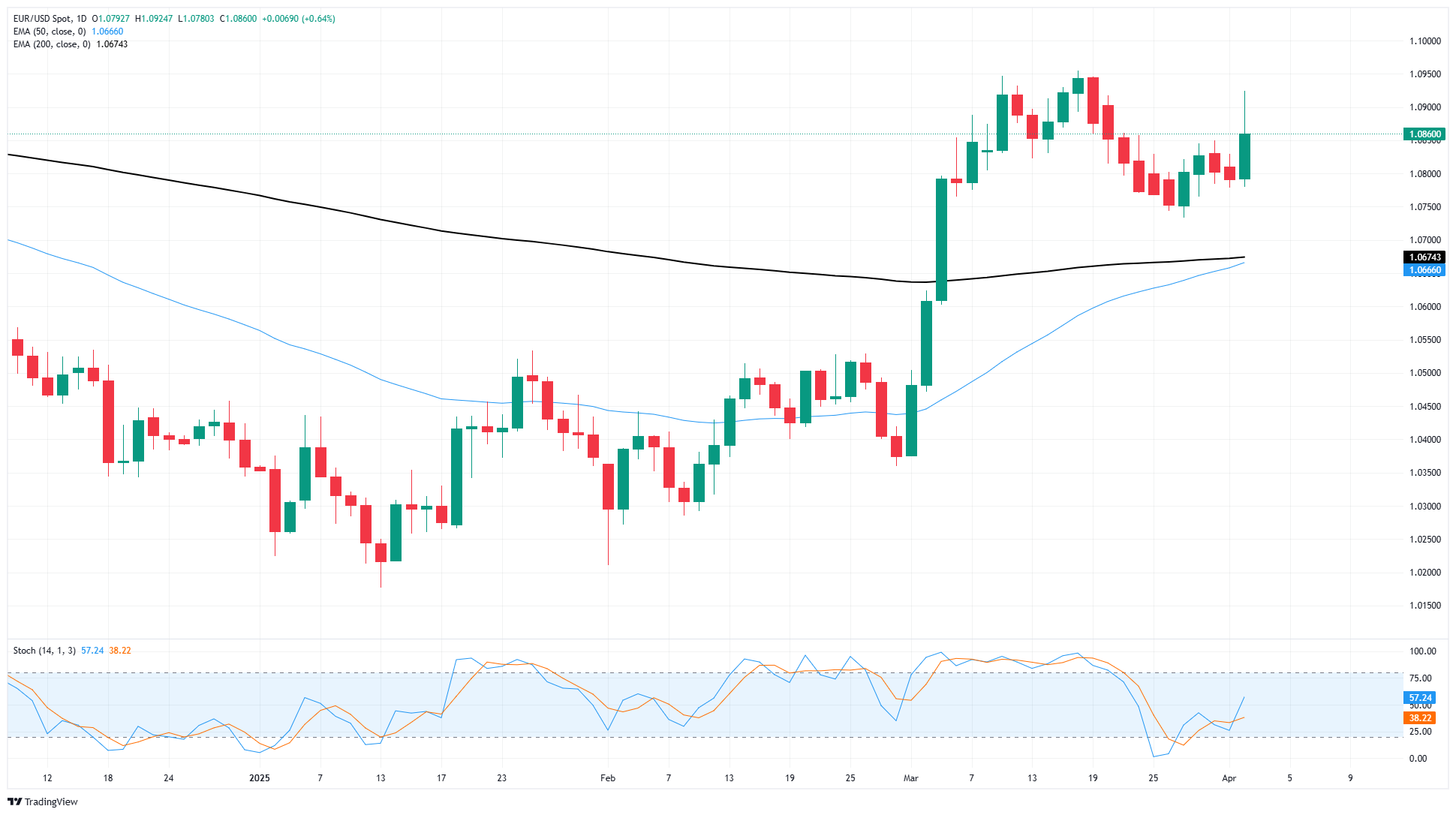EUR/USD pares post-tariff gains, but maintains bullish stance
- EUR/USD briefly tapped the 1.0900 level on Tuesday before falling back to familiar levels.
- Markets broadly handled tariff announcements from the Trump administration with little noise on Wednesday.
- Economic data takes a back seat to Trump tariff stress, but NFP still looms ahead.
On Wednesday, the EUR/USD pair saw a bullish surge after the Trump administration announced tariffs that turned out to be less severe than many investors had anticipated, given President Donald Trump’s barrage of tariff threats over the last 72 days. While the specifics of these tariff proposals are intricate, US consumers should prepare for a uniform 10% tariff on all imports, a hefty 25% tariff on all cars and car parts, and varying' reciprocal” tariffs imposed at different rates depending on the country.
Additionally, Trump reiterated his commitment to introduce further tariffs on items like copper, microchips, and other essential imported consumer products that are vital to the US economy. As these tariffs are likely to increase consumer prices in the upcoming months and there is no obvious alternative for the market to source foreign goods without incurring heavy import taxes, inflationary pressures are expected to rise soon and persist for a longer duration than desired. According to Federal Reserve (Fed) officials, the ambiguity surrounding the Trump administration’s trade policies is likely to maintain elevated interest rates for an extended period, surpassing previous expectations.
Read more: Trump announces reciprocal tariffs
European economic indicators will likely remain moderately unimportant for the rest of the trading week. Meanwhile, new US Nonfarm Payrolls (NFP) labor figures are expected this Friday. This NFP report could significantly influence the markets as the US economy transitions into a post-tariff phase, with the March labor statistics serving as a key indicator of the effects of the Trump administration’s tariff strategies.
EUR/USD price forecast
EUR/USD continues to trade in the middle of a technical trap, with buyers unable to take a firm leg higher, but short pressure too limited to push Fiber price action back under the 200-day Exponential Moving Average (EMA) just south of the 1.0700 handle.
EUR/USD snapped a near-term losing streak, pushing technical oscillators into oversold territory, but a continuation pattern remains unlikely as market participants focus on geopolitical factors.
EUR/USD daily chart
Euro FAQs
The Euro is the currency for the 19 European Union countries that belong to the Eurozone. It is the second most heavily traded currency in the world behind the US Dollar. In 2022, it accounted for 31% of all foreign exchange transactions, with an average daily turnover of over $2.2 trillion a day. EUR/USD is the most heavily traded currency pair in the world, accounting for an estimated 30% off all transactions, followed by EUR/JPY (4%), EUR/GBP (3%) and EUR/AUD (2%).
The European Central Bank (ECB) in Frankfurt, Germany, is the reserve bank for the Eurozone. The ECB sets interest rates and manages monetary policy. The ECB’s primary mandate is to maintain price stability, which means either controlling inflation or stimulating growth. Its primary tool is the raising or lowering of interest rates. Relatively high interest rates – or the expectation of higher rates – will usually benefit the Euro and vice versa. The ECB Governing Council makes monetary policy decisions at meetings held eight times a year. Decisions are made by heads of the Eurozone national banks and six permanent members, including the President of the ECB, Christine Lagarde.
Eurozone inflation data, measured by the Harmonized Index of Consumer Prices (HICP), is an important econometric for the Euro. If inflation rises more than expected, especially if above the ECB’s 2% target, it obliges the ECB to raise interest rates to bring it back under control. Relatively high interest rates compared to its counterparts will usually benefit the Euro, as it makes the region more attractive as a place for global investors to park their money.
Data releases gauge the health of the economy and can impact on the Euro. Indicators such as GDP, Manufacturing and Services PMIs, employment, and consumer sentiment surveys can all influence the direction of the single currency. A strong economy is good for the Euro. Not only does it attract more foreign investment but it may encourage the ECB to put up interest rates, which will directly strengthen the Euro. Otherwise, if economic data is weak, the Euro is likely to fall. Economic data for the four largest economies in the euro area (Germany, France, Italy and Spain) are especially significant, as they account for 75% of the Eurozone’s economy.
Another significant data release for the Euro is the Trade Balance. This indicator measures the difference between what a country earns from its exports and what it spends on imports over a given period. If a country produces highly sought after exports then its currency will gain in value purely from the extra demand created from foreign buyers seeking to purchase these goods. Therefore, a positive net Trade Balance strengthens a currency and vice versa for a negative balance.
